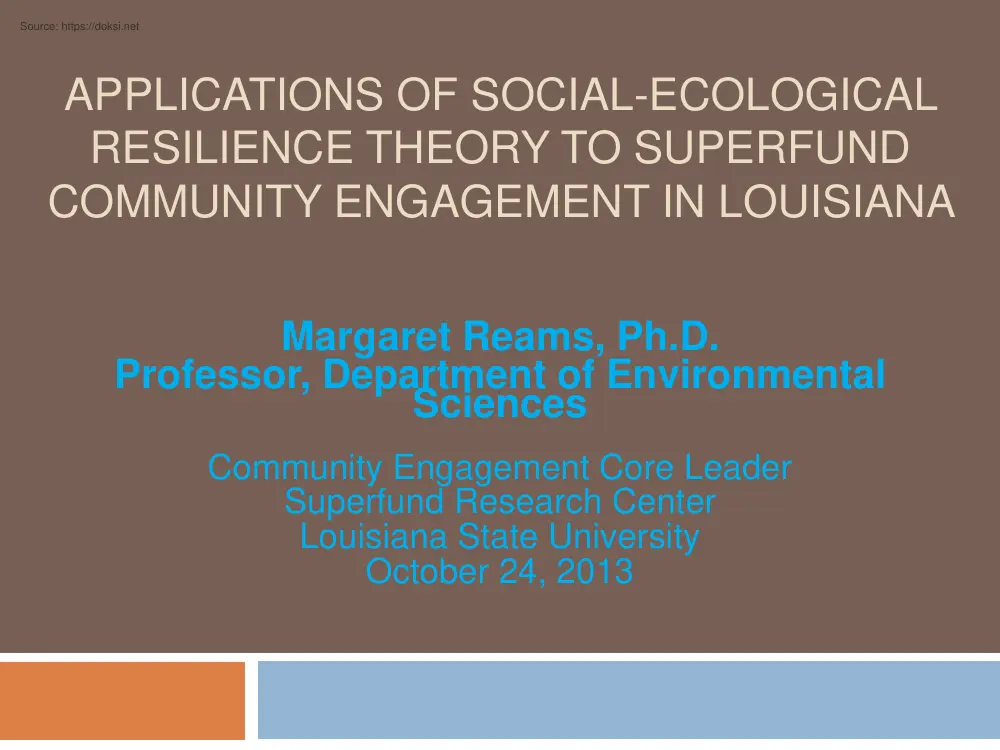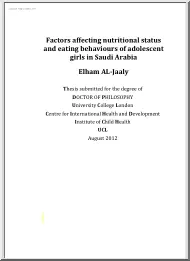Please log in to read this in our online viewer!

Please log in to read this in our online viewer!
No comments yet. You can be the first!
What did others read after this?
Content extract
APPLICATIONS OF SOCIAL-ECOLOGICAL RESILIENCE THEORY TO SUPERFUND COMMUNITY ENGAGEMENT IN LOUISIANA Margaret Reams, Ph.D Professor, Department of Environmental Sciences Community Engagement Core Leader Superfund Research Center Louisiana State University October 24, 2013 Thanks to Community Partners Louisiana Environmental Action Network (LEAN) Mary Queen of Vietnam Community Development Corporation (MQVCDC, New Orleans) LSU Colleagues Maud Walsh, Ph.D – LSU SRP Research Translation Core Leader; Betsy Paille, MS – Research Associate Nina Lam, Ph.D – Geographer and GIS Specialist Photo Credits: Getty Images, Maud Walsh, Belen Toscano Objective of SRP Engagement To enhance the capacity of communities facing cumulative environmental exposure risks to take steps to make themselves safer Key Questions What are common attributes of more resilient communities? How can SRP COEC efforts enhance these attributes among EJ communities? Some definitions
“Resilience reflects the degree to which a complex adaptive system is capable of self-organization and the degree to which the system can build capacity for learning and adaptation.” “The capacity of linked social-ecological systems to absorb recurrent disturbances such as hurricanes or floods so as to retain essential structures, processes, and feedbacks.” (From Adger et al., 2005, Science Vol 309) Utility of Social-Ecological Resilience Approach Social-Ecological Resilience provides a theory base and evaluative framework for: Adaptation to reduce exposure to or recovery from disruptive events – either fast-moving or slow-moving disturbances. Adaptations include individual behaviors and collective or community-level actions. Social-Ecological Resilience The Raft – A Metaphor of Stability and Resilience Ludwig’s model is useful. (2002) The raft’s system? Raft + Weight + Occupants Disruptions? Either rapid or slow increase weight. Key Variables?
Include Adaptive Behavior of Occupants How SRP Outreach Enhances Community Resilience Outreach Core Supports Leading to Realization of ATTRIBUTES OF STRONGER RESILIENCE COMMUNITIES KEY DIMENSIONS OF Social Networks Stable Relationships Information Sharing Self-Organizational Ability Access to Sound Science Risks Historic Local Knowledge Scientific Treatment of Knowledge of Mitigation Tools Stakeholder Participation in Public Decision Making Adaptive Ability 1. Examining Selected Adaptive Behaviors Among Residents First, we were interested in how this Resilience framework may be applied to adaptive strategies taken by residents of communities facing cumulative, slow-moving environmental exposure hazards. Little research has focused on residents of “Industrial Corridor” regions How do residents in neighborhoods with multiple sources of exposure perceive environmental risks and options for risk-reduction?
Map of North Baton Rouge Zip Code 70807 Shows 68 Facilities with Reported Hazardous Waste Activities Preliminary Study Reams, Margaret A., Nina SN Lam, Tabitha M Cale, and Corrinthia M. Hinton, 2013 “Applying a community resilience framework to examine household emergency planning and exposurereducing behavior among residents of Louisiana’s industrial corridor”, Journal of Emergency Management, 11(2), March/April: 107-121 Possible Influences On Household – Level Adaptive Behaviors “Resilience” = f(exposure, vulnerability, adaptive capacity) Exposure: Total TRI emissions by zip code; past environmental emergencies; number of facilities in neighborhood, etc. Vulnerability: Income; education; young children Adaptive Capacity: Membership in local groups; confidence in own knowledge and ability to reduce risks; adoption of other risk-reducing practices Interviews with Residents Interviews with 64 attendees of public meetings of the East Baton Rouge Parish Metro City
Council to determine activities and attitudes concerning several exposure-reducing behaviors. Also: Questions to indicate exposure (zip code of residence); socio-economic vulnerability; capacity to take steps to reduce exposure risks. Initial analysis to determine statistically significant associations among variables (Cross-tabs, Chi Sq.; Difference of Means testing) Adopted Household Emergency Plans? Only 22% of Interviewees Factors significantly associated with plan adoption: Exposure? (YES): Experienced environmental emergency during the last 5 years within one’s neighborhood Socioeconomic Vulnerability? (NO): Less-educated actually more likely to adopt plan Capacity to Adapt? (YES): Confidence in ability to cope with emergencies, Early Encouraging Implications for Engagement Efforts in EJ Communities Knowledge and Confidence in one’s ability to reduce exposure risks appear to be associated with adaptive, risk-reducing behavior The COEC program should be
able to help build capacity for community resilience through encouraging self-organization among residents, providing scientific information concerning risks; and sharing information about specific adaptive strategies to reduce exposure risks. 2. Addressing a Climate of Polarization Earlier this year, we partnered with Oregon State University’s SRP and LEAN to convene the symposium and: Response, Recovery, and Resilience to Oil Spills and Environmental Disasters: Engaging Experts and Communities First Step to Improve Communication The meeting was a diverse gathering of leaders of Louisiana and Gulf Coast regional NGO’s, state regulatory agencies, community residents and academic researchers to examine events following Hurricanes Katrina and Rita of 2005, the BP Gulf Oil Spill of 2010, and 2012’s Hurricane Isaac, provided a venue for a cross-section of individuals to explore how improvements in pre-emergency planning, post-event monitoring of environmental
conditions, and better communication of exposure risks, could encourage stronger recovery and enhance the overall resilience of communities. Recommendations of Participants Pre-event planning to identify on-site contaminants and environmental monitoring protocols Pre-trained teams of “citizen scientists” to monitor local environmental conditions Improved communication and data-sharing concerning environmental conditions following storms and large-scale disturbances Greater utilization of innovative sampling techniques New partnerships between residents and regulators 3. Building the Capacities of EJ Communities Creation of a “Citizen Science” Guidebook for the local member groups of the larger Louisiana Environmental Action Network. This is a list of resources and “best practices” for local groups Also, the guide will contain several case studies of successful efforts. Upcoming workshop with LEAN community members to introduce
the guidebook. How SRP Outreach Enhances Resilience Outreach Core Supports Leading to Realization of ATTRIBUTES OF STRONGER RESILIENCE COMMUNITIES KEY DIMENSIONS OF Social Networks Stable Relationships Information Sharing Self-Organizational Ability Access to Sound Science Risks Historic Local Knowledge Scientific Treatment of Knowledge of Mitigation Tools Stakeholder Participation in Public Decision Making Adaptive Ability
“Resilience reflects the degree to which a complex adaptive system is capable of self-organization and the degree to which the system can build capacity for learning and adaptation.” “The capacity of linked social-ecological systems to absorb recurrent disturbances such as hurricanes or floods so as to retain essential structures, processes, and feedbacks.” (From Adger et al., 2005, Science Vol 309) Utility of Social-Ecological Resilience Approach Social-Ecological Resilience provides a theory base and evaluative framework for: Adaptation to reduce exposure to or recovery from disruptive events – either fast-moving or slow-moving disturbances. Adaptations include individual behaviors and collective or community-level actions. Social-Ecological Resilience The Raft – A Metaphor of Stability and Resilience Ludwig’s model is useful. (2002) The raft’s system? Raft + Weight + Occupants Disruptions? Either rapid or slow increase weight. Key Variables?
Include Adaptive Behavior of Occupants How SRP Outreach Enhances Community Resilience Outreach Core Supports Leading to Realization of ATTRIBUTES OF STRONGER RESILIENCE COMMUNITIES KEY DIMENSIONS OF Social Networks Stable Relationships Information Sharing Self-Organizational Ability Access to Sound Science Risks Historic Local Knowledge Scientific Treatment of Knowledge of Mitigation Tools Stakeholder Participation in Public Decision Making Adaptive Ability 1. Examining Selected Adaptive Behaviors Among Residents First, we were interested in how this Resilience framework may be applied to adaptive strategies taken by residents of communities facing cumulative, slow-moving environmental exposure hazards. Little research has focused on residents of “Industrial Corridor” regions How do residents in neighborhoods with multiple sources of exposure perceive environmental risks and options for risk-reduction?
Map of North Baton Rouge Zip Code 70807 Shows 68 Facilities with Reported Hazardous Waste Activities Preliminary Study Reams, Margaret A., Nina SN Lam, Tabitha M Cale, and Corrinthia M. Hinton, 2013 “Applying a community resilience framework to examine household emergency planning and exposurereducing behavior among residents of Louisiana’s industrial corridor”, Journal of Emergency Management, 11(2), March/April: 107-121 Possible Influences On Household – Level Adaptive Behaviors “Resilience” = f(exposure, vulnerability, adaptive capacity) Exposure: Total TRI emissions by zip code; past environmental emergencies; number of facilities in neighborhood, etc. Vulnerability: Income; education; young children Adaptive Capacity: Membership in local groups; confidence in own knowledge and ability to reduce risks; adoption of other risk-reducing practices Interviews with Residents Interviews with 64 attendees of public meetings of the East Baton Rouge Parish Metro City
Council to determine activities and attitudes concerning several exposure-reducing behaviors. Also: Questions to indicate exposure (zip code of residence); socio-economic vulnerability; capacity to take steps to reduce exposure risks. Initial analysis to determine statistically significant associations among variables (Cross-tabs, Chi Sq.; Difference of Means testing) Adopted Household Emergency Plans? Only 22% of Interviewees Factors significantly associated with plan adoption: Exposure? (YES): Experienced environmental emergency during the last 5 years within one’s neighborhood Socioeconomic Vulnerability? (NO): Less-educated actually more likely to adopt plan Capacity to Adapt? (YES): Confidence in ability to cope with emergencies, Early Encouraging Implications for Engagement Efforts in EJ Communities Knowledge and Confidence in one’s ability to reduce exposure risks appear to be associated with adaptive, risk-reducing behavior The COEC program should be
able to help build capacity for community resilience through encouraging self-organization among residents, providing scientific information concerning risks; and sharing information about specific adaptive strategies to reduce exposure risks. 2. Addressing a Climate of Polarization Earlier this year, we partnered with Oregon State University’s SRP and LEAN to convene the symposium and: Response, Recovery, and Resilience to Oil Spills and Environmental Disasters: Engaging Experts and Communities First Step to Improve Communication The meeting was a diverse gathering of leaders of Louisiana and Gulf Coast regional NGO’s, state regulatory agencies, community residents and academic researchers to examine events following Hurricanes Katrina and Rita of 2005, the BP Gulf Oil Spill of 2010, and 2012’s Hurricane Isaac, provided a venue for a cross-section of individuals to explore how improvements in pre-emergency planning, post-event monitoring of environmental
conditions, and better communication of exposure risks, could encourage stronger recovery and enhance the overall resilience of communities. Recommendations of Participants Pre-event planning to identify on-site contaminants and environmental monitoring protocols Pre-trained teams of “citizen scientists” to monitor local environmental conditions Improved communication and data-sharing concerning environmental conditions following storms and large-scale disturbances Greater utilization of innovative sampling techniques New partnerships between residents and regulators 3. Building the Capacities of EJ Communities Creation of a “Citizen Science” Guidebook for the local member groups of the larger Louisiana Environmental Action Network. This is a list of resources and “best practices” for local groups Also, the guide will contain several case studies of successful efforts. Upcoming workshop with LEAN community members to introduce
the guidebook. How SRP Outreach Enhances Resilience Outreach Core Supports Leading to Realization of ATTRIBUTES OF STRONGER RESILIENCE COMMUNITIES KEY DIMENSIONS OF Social Networks Stable Relationships Information Sharing Self-Organizational Ability Access to Sound Science Risks Historic Local Knowledge Scientific Treatment of Knowledge of Mitigation Tools Stakeholder Participation in Public Decision Making Adaptive Ability




 When reading, most of us just let a story wash over us, getting lost in the world of the book rather than paying attention to the individual elements of the plot or writing. However, in English class, our teachers ask us to look at the mechanics of the writing.
When reading, most of us just let a story wash over us, getting lost in the world of the book rather than paying attention to the individual elements of the plot or writing. However, in English class, our teachers ask us to look at the mechanics of the writing.